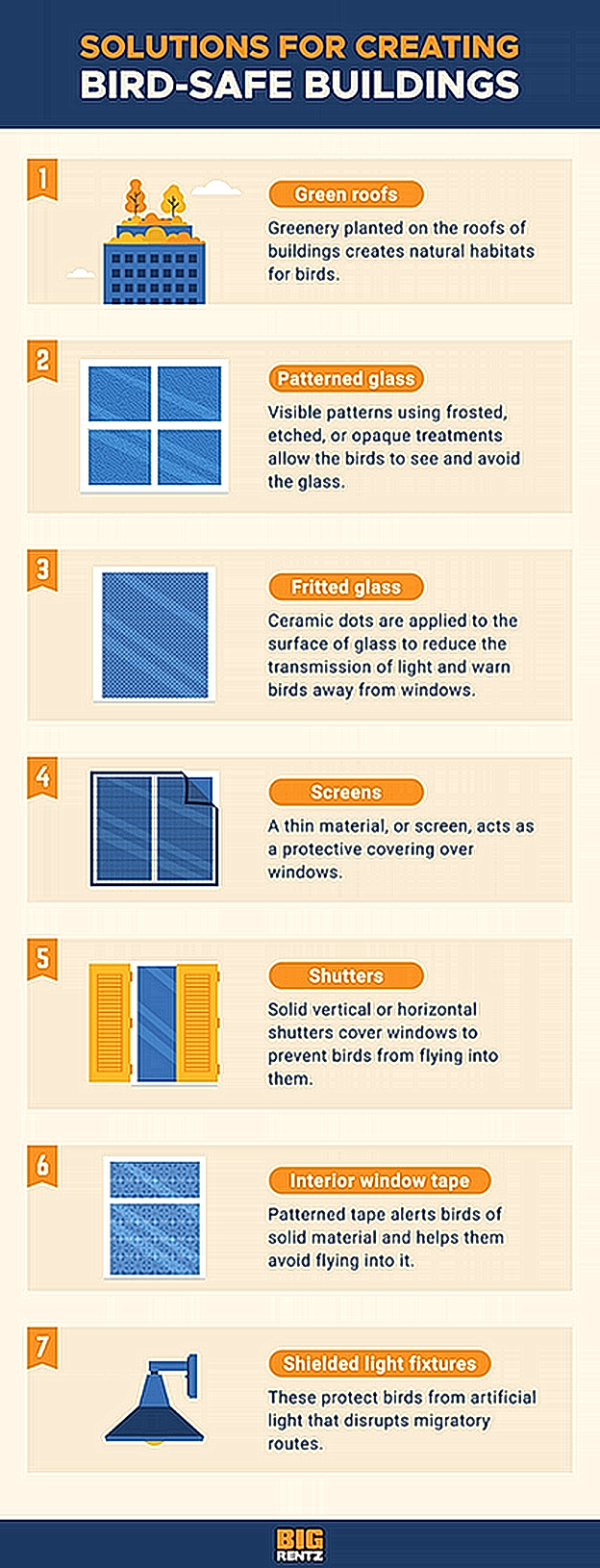- + LET'S GO THERE
- SKIING / WINTER ADVENTURE
- + THINGS TO DO
- + TOURS
- + WINE & DINE
- + STAY
- CALENDAR
- + MAPS, BLOGS & MORE
- Site Search
A Bird Lover’s Guide to the Creation of Bird-Safe Buildings
posted by Rachel Perez at 2022-01-10 16:36:00
Birds are some of nature’s most beautiful and essential beings. They help pollinate, control pests, and they can be thrilling to watch in their natural habitats. However, what happens when humans begin to infringe upon that habitat? Unfortunately, the sad truth is that birds and human construction often don’t mix.
In short: buildings are dangerous for birds. Up to a billion birds die every year from striking buildings. And while one might think cities and high rises are the main culprits, the opposite is true. Less than 1% of building-strike fatalities occur on structures taller than 11 stories.
Fortunately, the tides are beginning to change. Recent local legislations and a growing call for bird safety in building codes have led to this reawakening. Through these means, the importance of bird safety is becoming increasingly evident. From skyscrapers to personal homes, there are many steps to be taken to help protect birds from the dangers of buildings. As well, many of these solutions can be utilized by private homeowners across the country. Here is a bird lover’s guide to bird-safe buildings.


Identify and Eliminate Bird Threats
Making buildings bird-safe starts with identifying the causes of issues. Three main components are often the most significant cause of bird-to-building collisions. They are:- Reflective glass, including windows and decorative fixtures.
- Transparent glass, which is invisible to birds.
- Artificial light, from both internal and external sources.
If you lack a yard, your windows can still be a danger to our flying friends. As birds don’t understand the function of a window, they don’t realize the existence of glass until it’s too late. Watch the birds in your area and study if they are attracted to your home or residence. If you live in a high bird-traffic area, you might need to address your windows for their bird safety.
Likewise, artificial lights can confuse birds as they fly, especially at night. Their powerful glow can also attract birds directly, thus leading to building strikes. These lights can mimic sunlight, which many birds use to travel. If an artificial light source happens to be behind a closed window, it could spell trouble for passing birds.
To understand how your building can be dangerous to birds, you must think like a bird. Identifying threats to birds is the first step to keeping them safe.

Turn to Bird-Safe Solutions
From businesses to private homes, everyone can start fixing unsafe building conditions. A building’s bird safety is a LEED-certified rating. This rating is based on the threat factor of its various components, including reflective windows and light sources. Bird-friendly materials must have a threat factor of 30 or lower. This rating corresponds to a 50% reduction of bird accidents, at a minimum.
Because of this, the easiest way to make a building bird-safe is to switch to bird-safe materials. These include:
- Patterned glass windows, using frosted or etched glass to make windows visible to birds.
- Fritted glass, using ceramic dots to reduce light and heat transmission to warn birds away.
- Screens and shutters, designed to eliminate reflectivity.
- Window tape, used to create patterns that birds can see.
- Shield light fixtures, made to direct light down to reduce bird attraction and light pollution.

Don’t Forget the Environment
Of course, another way to help ensure birds’ safety is to turn your backyard into a bird sanctuary. As mentioned above, offering shelter and water areas will help divert birds away from the building itself. And a backyard designed around birds will provide endless bird-watching opportunities.
A bird-safe yard provides several (or all) of the following features:
- Shelter (nesting areas or birdhouses)
- Specialized food and feeders
- Water areas (for drinking and bathing)
- Appropriate lighting
Likewise, be sure to supply plenty of water. Songbirds enjoy fresh water, and will reward your actions with their music.
Birds are important, and far too many perish from flying into buildings. Still, we can all take steps to avoid these tragic occurrences, even while protective legislation works its way through Congress. Making your home or building bird-safe can be as simple as taping patterns on your windows. Or, you can turn your entire yard into a bird sanctuary. Whichever route you follow, protecting birds is a duty we can all get behind.
posted at: 2022-01-10 16:36:00, last updated: 2022-04-05 14:05:01
















